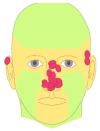Challenges for New Adopters in Pre-Surgical Margin Assessment by Handheld Reflectance Confocal Microscope of Basal Cell Carcinoma; A Prospective Single-center Study
- PMID: 36534521
- PMCID: PMC9681170
- DOI: 10.5826/dpc.1204a162
Challenges for New Adopters in Pre-Surgical Margin Assessment by Handheld Reflectance Confocal Microscope of Basal Cell Carcinoma; A Prospective Single-center Study
Abstract
Introduction: In vivo reflectance confocal microscopy (RCM) is a useful tool for assessing pre-surgical skin tumor margins when performed by a skilled, experienced user. The technique, however, poses significant challenges to novice users, particularly when a handheld RCM (HRCM) device is used.
Objectives: To evaluate the performance of an HRCM device operated by a novice user to delineate basal cell carcinoma (BCC) margins before Mohs micrographic surgery (MMS).
Methods: Prospective study of 17 consecutive patients with a BCC in a high-risk facial area (the H zone) in whom tumor margins were assessed by HRCM and dermoscopy before MMS. Predicted surgical defect areas (cm2) were calculated using standardized photographic digital documentation and compared to final defect areas after staged excision.
Results: No significant differences were observed between median HRCM-predicted and observed surgical defect areas (2.95 cm2 [range: 0.83-17.52] versus 2.52 cm2 [range 0.71-14.42]; P = 0.586). Dermoscopy, by contrast, produced significantly underestimated values (median area of 1.34 cm2 [0.41-4.64] versus 2.52 cm2 [range 0.71-14.42]; P < 0.001). Confounders leading to poor agreement between predicted and observed areas were previous treatment (N = 5), a purely infiltrative subtype (N = 1), and abundant sebaceous hyperplasia (N = 1).
Conclusions: Even in the hands of a novice user, HRCM is more accurate than dermoscopy for delineating lateral BCCs margins in high-risk areas and performs well at predicting final surgical defects.
Keywords: basal cell carcinoma; margin control; micrographic Mohs surgery; reflectance confocal microscopy.
©2022 Richarz et al.
Conflict of interest statement
Competing interests: None.
Figures


References
Publication types
LinkOut - more resources
Full Text Sources
